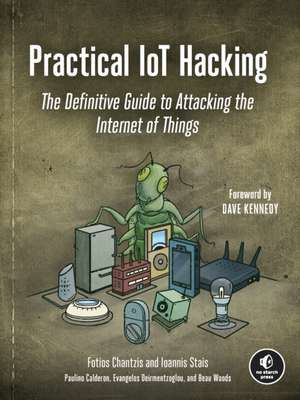Practical IoT Hacking: The Definitive Guide to Attacking the Internet of Things
Autor Fotios Chantzis, Evangel Deirme, Ioannis Staisen Limba Engleză Paperback – 8 apr 2021
Geared towards security researchers, IT teams, and penetration testers, application testers, developers, and IT administrators, this book teaches readers how to get started with hacking Internet connected devices. Readers dig deep into technical (and related legal) issues, as they learn what kinds of devices to use as hacking tools and which make the best targets. The authors, all experts in the field, cover the kinds of vulnerabilities found in IoT devices, explain how to exploit their network protocols, and how to leverage security flaws and certain hardware interfaces found in the physical devices themselves.
The book begins with threat modeling and a security testing methodology, then covers how to attack hardware interfaces such as UART, IᄇC, SPI, JTAG / SWD and IoT network protocols like UPnP, WS-Discovery, mDNS, DNS-SD, RTSP / RTCP / RTP, LoRa / LoRaWAN, Wi-Fi / Wi-Fi Direct, RFID / NFC, BLE, MQTT, CDP and DICOM. Examples throughout offer custom code designed to demonstrate specific vulnerabilities and tools to help readers reproduce the attacks. Practical IoT Hacking is full of practical exercises and hands-on examples taken from the authors' own research that teach readers things like how to bypass the authentication of an STM32F103 device (black pill) through SWD; reverse firmware; exploit zero-configuration networking; use low-cost equipment to capture LoRa network traffic; analyze IoT companion mobile apps, take over and remotely control an Android based treadmill, jam wireless devices such as home alarm systems, hijack Bluetooth Low Energy connections and how to circumvent modern RFID and NFC enabled smart door locks.
Preț: 233.67 lei
Preț vechi: 349.05 lei
-33% Nou
44.72€ • 48.56$ • 37.56£
Carte disponibilă
Livrare economică 04-15 aprilie
Livrare express 15-21 martie pentru 88.66 lei
Specificații
ISBN-10: 1718500904
Pagini: 464
Dimensiuni: 178 x 235 x 34 mm
Greutate: 0.91 kg
Editura: Penguin Random House Group
Colecția No Starch Press
Locul publicării:United States
Descriere
The definitive guide to hacking the world of the Internet of Things (IoT) -- Internet connected devices such as medical devices, home assistants, smart home appliances and more.
Geared towards security researchers, IT teams, and penetration testers, application testers, developers, and IT administrators, this book teaches readers how to get started with hacking Internet connected devices. Readers dig deep into technical (and related legal) issues, as they learn what kinds of devices to use as hacking tools and which make the best targets. The authors, all experts in the field, cover the kinds of vulnerabilities found in IoT devices, explain how to exploit their network protocols, and how to leverage security flaws and certain hardware interfaces found in the physical devices themselves.
The book begins with threat modeling and a security testing methodology, then covers how to attack hardware interfaces such as UART, IᄇC, SPI, JTAG / SWD and IoT network protocols like UPnP, WS-Discovery, mDNS, DNS-SD, RTSP / RTCP / RTP, LoRa / LoRaWAN, Wi-Fi / Wi-Fi Direct, RFID / NFC, BLE, MQTT, CDP and DICOM. Examples throughout offer custom code designed to demonstrate specific vulnerabilities and tools to help readers reproduce the attacks. Practical IoT Hacking is full of practical exercises and hands-on examples taken from the authors' own research that teach readers things like how to bypass the authentication of an STM32F103 device (black pill) through SWD; reverse firmware; exploit zero-configuration networking; use low-cost equipment to capture LoRa network traffic; analyze IoT companion mobile apps, take over and remotely control an Android based treadmill, jam wireless devices such as home alarm systems, hijack Bluetooth Low Energy connections and how to circumvent modern RFID and NFC enabled smart door locks.
























